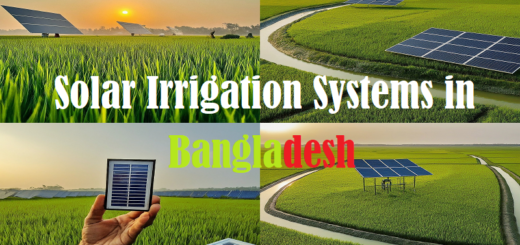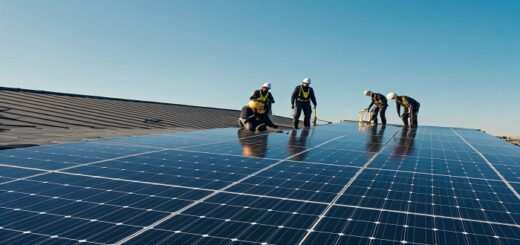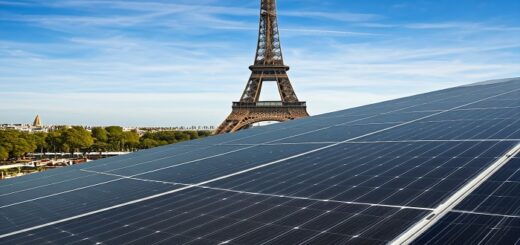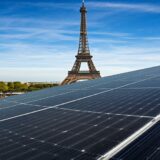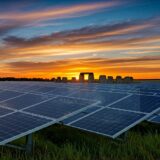Can I Install both Solar & Wind Systems to Power My Home
Dreaming of a home powered by clean, renewable energy? You’re not alone! Solar panels have become increasingly popular, but what if you could combine them with another renewable source? Let’s explore the possibility of installing both solar and wind systems to create a hybrid home energy system. Can I Install both Solar & Wind Systems to Power My Home?
Solar Power
Sunshine is a powerful resource, and solar panels convert it into electricity. Sunlight hits the panels, knocking electrons loose and creating a flow of electricity. This direct current (DC) is then converted to alternating current (AC) by an inverter, making it usable for your home appliances.
Wind Power
Wind turbines capture the energy of moving air. As the wind spins the blades, a shaft inside the turbine converts that rotation into electricity. Similar to solar panels, wind turbines generate DC electricity that needs conversion to AC for powering your home.
Going Hybrid: Sun and Wind Together
While both solar and wind are renewable sources, they have different strengths and weaknesses. Solar panels shine (pun intended!) during sunny days, but produce little to no electricity at night. Wind turbines, on the other hand, can generate power 24/7, but rely on consistent wind speeds.
This is where a hybrid system comes in. Combining solar and wind allows you to harness the power of both elements, creating a more reliable and consistent source of renewable energy for your home. Here’s why a hybrid approach might be a good fit:
Complementary Power Generation: Solar and wind often peak at different times. When the sun is blazing, wind speeds might be lower, and vice versa. By combining them, you’re more likely to have power generation throughout the day and night.
Reduced Reliance on the Grid: A hybrid system can significantly reduce the amount of electricity you draw from the traditional power grid, potentially leading to lower electricity bills and increased energy independence.
Environmental Benefits: By relying more on renewable sources, you’ll be reducing your carbon footprint and contributing to a cleaner environment.
Is Hybrid Right for You?
While a hybrid system offers several advantages, it’s not a one-size-fits-all solution. Here are some factors to consider before you take the plunge:
- Location, Location, Location: Solar panels require sufficient sunlight, while wind turbines need consistent wind speeds. Research average wind speeds and sun hours in your area to see if a hybrid system is viable.
- Land Availability: Wind turbines require more space than solar panels, especially larger models that can generate significant power. Make sure you have enough land to accommodate a wind turbine safely.
- Initial Investment: Hybrid systems can be more expensive upfront compared to solar panels alone. However, government incentives and potential long-term savings on electricity bills can help offset the initial cost.
- Local Regulations: Some areas might have zoning restrictions or noise ordinances that limit the installation of wind turbines. Check your local regulations before investing in a hybrid system.
Exploring Solar and Wind Options
If you’re interested in a hybrid system, here’s a breakdown of the typical components:
- Solar Panels: These come in various sizes and capacities. You’ll need to assess your energy needs to determine the right number of panels.
- Wind Turbine: For residential use, smaller, vertical-axis wind turbines are more common. Consider factors like wind speed and noise output when choosing a turbine.
- Inverter: This converts DC electricity from both solar panels and wind turbines into usable AC electricity for your home.
- Battery Bank (Optional): Storing excess energy allows you to use it at night or during times of low wind or sun. Battery banks add complexity and cost to the system.
- Charge Controller (Optional): This regulates the flow of electricity between the solar panels, wind turbine, batteries, and your home’s electrical system.
Installation Considerations
Installing a hybrid system is a complex undertaking. It’s crucial to work with qualified professionals who can assess your site, design a system that meets your needs, and ensure proper installation.
Here are some key considerations for installation:
- Roof Strength: Solar panels add weight to your roof. Ensure your roof structure can support the additional weight of the panels.
- Wind Turbine Placement: Turbines need to be placed in an open area with minimal obstructions for optimal wind capture. Safety is paramount, so ensure proper distance from your home and other structures.
- Electrical System Upgrade: Your existing electrical system might need modifications to accommodate the additional power input from a hybrid system.
Going Hybrid: Weighing the Pros and Cons
While the idea of a hybrid system is exciting, it’s important to understand the complete picture. Here’s a deeper dive into the advantages and disadvantages to help you decide if a hybrid system is the right choice for you.
Advantages of a Hybrid System:
- Increased Energy Security: With both solar and wind power sources, you’re less reliant on the traditional grid. This can be especially beneficial during power outages or grid instability.
- More Predictable Power Generation: By combining solar and wind, you can create a more predictable energy flow throughout the day and night. This reduces your reliance on backup generators or battery storage.
- Potential for Government Incentives: Many governments offer financial incentives to encourage the adoption of renewable energy. These incentives can help offset the upfront cost of a hybrid system.
- Reduced Reliance on Fossil Fuels: By generating your own clean energy, you’ll be contributing to a cleaner environment and reducing your dependence on fossil fuels.
Disadvantages of a Hybrid System:
- Higher Initial Cost: Hybrid systems typically cost more upfront compared to solar panels alone. The additional cost of a wind turbine and potentially a larger inverter can be significant.
- Increased Maintenance Needs: Both solar panels and wind turbines require regular maintenance to ensure optimal performance. Wind turbines, with their moving parts, generally require more maintenance than solar panels.
- Complexity: Hybrid systems are more complex than standalone solar or wind systems. This complexity can make them more challenging to install and troubleshoot.
- Space Requirements: Wind turbines require a clear area with minimal obstructions for efficient wind capture. This might not be feasible for everyone, especially in urban or densely populated areas.
- Noise Concerns: Wind turbines can generate noise, which might be a concern for some homeowners. Research noise output specifications before choosing a turbine.
Financial Considerations: Crunch the Numbers
The financial viability of a hybrid system depends on several factors, including:
- System Cost: This includes the cost of equipment, installation, and any required permits.
- Government Incentives: Research available incentives in your area that can significantly reduce the upfront cost.
- Energy Savings: Estimate the amount of electricity you’ll generate with a hybrid system and the potential savings on your electricity bills.
- Maintenance Costs: Factor in the ongoing costs of maintaining both the solar panels and the wind turbine.
By carefully considering these factors, you can create a financial model to determine if a hybrid system makes sense for your budget and your energy needs.
The Future of Hybrid Power
Technological advancements are constantly improving the efficiency and affordability of hybrid systems. Here are some trends to watch:
- Smarter Systems: Advanced control systems can optimize energy production and storage, making hybrid systems even more efficient.
- Battery Technology Advancements: Improvements in battery storage capacity and affordability will make storing excess energy more practical, further enhancing the benefits of hybrid systems.
- Microgrid Integration: Hybrid systems could be integrated into microgrids, creating self-contained communities that generate and manage their own clean energy.
While hybrid systems are not a one-size-fits-all solution, they offer a promising path towards a more sustainable and independent energy future. By carefully considering the factors discussed above, you can determine if a hybrid system is the right choice to power your home with clean, renewable energy.



